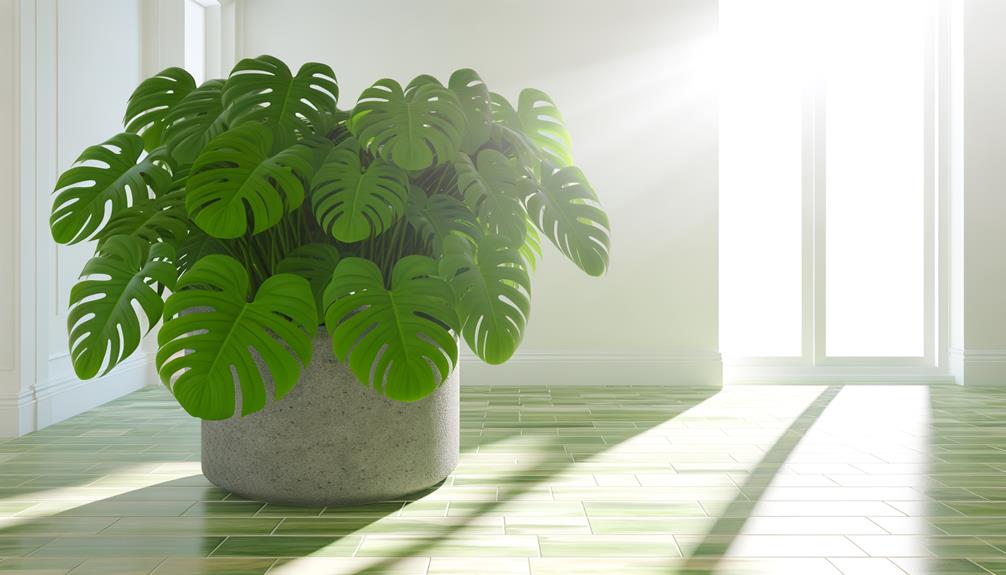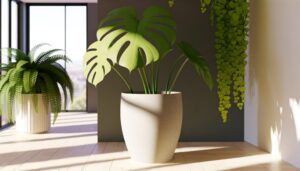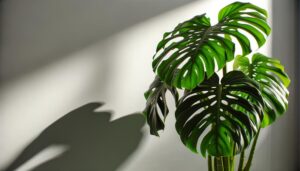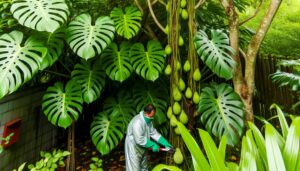Can I Keep Multiple Monstera Deliciosa Plants in One Pot?
You can keep multiple Monstera deliciosa plants in one pot if the pot is large enough, at least 12 inches deep, to provide sufficient space for root growth. Use well-draining soil rich in organic matter and ensure the pot has drainage holes.
Maintain ideal humidity (60-80%) and place the pot under bright, indirect light. Regularly monitor and adjust water levels to prevent root rot.
Root entanglement and soil nutrient depletion may occur, so frequent checks are essential. If you manage these factors well, your plants will thrive.
For a deeper insight into best practices, continue further.

Key Takeaways
- Ensure adequate space for root growth to prevent entanglement and root rot.
- Use a large pot with a minimum depth of 12 inches for multiple plants.
- Monitor soil moisture levels and adjust watering to meet varying needs.
- Provide bright, indirect light and maintain high humidity for optimal growth.
- Regularly check for signs of overcrowding and repot if necessary.
Benefits of Group Planting
Group planting Monstera Deliciosa can boost humidity, stabilize soil temperature, and create a microenvironment conducive to healthy growth. When you group these plants, their combined transpiration increases ambient humidity, benefiting all members. Higher humidity levels can lessen water stress and promote lush foliage.
In addition, multiple plants in one pot can help regulate soil temperature by providing shade and reducing direct sunlight exposure. This temperature stabilization minimizes root temperature fluctuations, fostering consistent growth conditions. Moreover, the close proximity of multiple plants creates a microenvironment that can deter pests and diseases. The shared root zone encourages beneficial microbial activity, enhancing nutrient uptake.
For best results, make sure to have proper drainage and monitor moisture levels to prevent root rot.
Space and Root Growth
While the benefits of group planting are significant, ensuring each Monstera Deliciosa has adequate space for root growth is paramount for sustained health and vigor.
Monstera roots need ample room to expand, absorbing nutrients and water efficiently. Crowded roots can become entangled, leading to restricted growth and potential root rot. Use a large pot with a minimum depth of 12 inches to provide sufficient space.
Regularly monitor root development, and if you notice roots circling the pot’s edge, it’s time to repot. Aerate the soil periodically to promote healthy root respiration.
Soil and Water Requirements
Optimizing ideal soil and water conditions for your Monstera Deliciosa is vital to nurturing healthy growth and preventing common issues like root rot or nutrient deficiencies. Use well-draining soil rich in organic matter. A blend of potting soil, orchid bark, and perlite works effectively, providing aeration and preventing waterlogging.
Water your plants when the top inch of soil feels dry; overwatering can suffocate roots and cause rot. Ensure the pot has drainage holes to allow excess water to escape. Employ a consistent watering schedule, but adjust based on seasonal changes and indoor humidity levels. Monitor for signs of overwatering, such as yellowing leaves, and under-watering, like wilting.
Proper soil and water management is essential for thriving Monstera Deliciosa plants.
Light and Humidity Needs
In addition to proper soil and water management, Monstera Deliciosa plants thrive under bright, indirect light and high humidity levels. You should place your plants near a window with filtered sunlight. Avoid direct sunlight as it can scorch the leaves. Aim for 60-80% humidity for optimal growth, which can be achieved using a humidifier or by misting the leaves regularly.
| Light Level | Humidity Level | Maintenance Tips |
|---|---|---|
| Bright, indirect | 60-80% | Use sheer curtains |
| Partially shaded | 50-60% | Mist leaves daily |
| Direct sunlight | 40-50% | Rotate plants weekly |
| Low light | <40% | Increase artificial light |
| Artificial light | Variable | Use grow lights |
Common Problems
When growing multiple Monstera deliciosa plants in one pot, you’ll face several challenges. Root system conflict can lead to overcrowding, while watering can become inconsistent, causing either drought stress or waterlogging.
Additionally, light distribution issues might result in uneven growth, affecting the overall health of your plants.
Root System Conflict
Crowded roots can lead to competition for nutrients and water, ultimately stunting the growth of your Monstera Deliciosa plants. When multiple plants share a single pot, their roots intertwine, creating a dense network that restricts space. This can result in nutrient deficiencies and insufficient water absorption, weakening the plants.
- Nutrient Deficiencies: Limited access to essential elements can cause yellowing leaves and poor growth.
- Root Rot: Overcrowded roots are more susceptible to fungal infections, leading to decay.
- Stunted Growth: Competing roots can’t extend properly, restricting overall development.
- Stress: Monstera plants under stress are more vulnerable to pests and diseases.
To prevent root system conflict, consider repotting each plant into its own container, ensuring ample space for healthy growth.
Watering Challenges
Watering multiple Monstera Deliciosa plants in a single pot presents unique challenges due to varying moisture needs and competition, often leading to overwatering or underwatering issues. Each plant’s roots compete for water, and soil may dry out unevenly. Overwatering can cause root rot, while underwatering stresses the plants.
Monitor soil moisture levels closely using a moisture meter. Water when the top 2-3 inches of soil are dry. Guarantee the pot has drainage holes to prevent waterlogging. Use a well-draining, aerated soil mix to facilitate proper moisture distribution. Adjust watering frequency based on environmental conditions like humidity and temperature.
Regularly inspect roots for signs of rot or dryness, and adjust care practices accordingly to maintain healthy growth.
Light Distribution Issues
Promoting proper light distribution among multiple Monstera Deliciosa plants in one pot proves challenging, as uneven light exposure can lead to leggy growth and hinder photosynthesis efficiency. When plants compete for light, some may dominate, leaving others deprived. This asymmetry can compromise their health and aesthetic appeal.
Consider these potential issues:
- Stunted Growth: Inadequate light can cause smaller, less vibrant leaves.
- Pest Attraction: Weak plants are more susceptible to pests.
- Overcrowding: Dense foliage blocks light, exacerbating the problem.
- Resource Imbalance: Uneven light affects nutrient uptake.
To address these issues, rotate the pot regularly, use grow lights if natural light is insufficient, and prune strategically to allow better light penetration. This approach guarantees each plant receives sufficient light, promoting uniform growth.
Best Practices
To maintain healthy growth when grouping multiple Monstera deliciosa in one pot, you must consider:
- Pot size
- Soil composition
- Drainage capabilities
Adequate light and consistent watering are also essential for maintaining plant health.
Let’s examine these factors to optimize your Monstera’s environment.
Pot Size Matters
Choosing the correct pot size for multiple Monstera deliciosa plants is important for their root health and overall growth. When selecting a pot, make sure it provides adequate space for each plant’s root system to expand without becoming entangled or restricted. A pot that’s too small can lead to root-bound conditions, stunted growth, and poor health. Conversely, an excessively large pot can cause waterlogging and root rot.
To get it right, consider these factors:
- Root Space: Ensures each plant receives sufficient nutrients and oxygen.
- Growth Potential: Accommodates future growth without frequent repotting.
- Stability: Prevents the pot from tipping over as plants grow taller.
- Aesthetics: Complements your home decor while supporting plant health.
Choosing the right pot size is essential for thriving Monstera deliciosa plants.
Soil and Drainage
Proper soil composition and effective drainage are critical for the health and growth of multiple Monstera deliciosa plants in a single pot. Use a well-draining potting mix with high organic content. A mix of peat moss, perlite, and orchid bark guarantees aeration and moisture retention. Avoid heavy soils that can lead to root rot.
Make sure the pot has drainage holes to prevent waterlogging. Elevate the pot slightly to improve drainage further. Monitor the soil moisture; it should be evenly moist but not soggy. Implementing these practices prevents fungal infections and promotes robust root development.
Light and Water
Ensuring ideal light and water conditions is essential for maintaining the health and vigor of multiple Monstera deliciosa plants in a single pot. Provide bright, indirect light to prevent leaf scorching while promoting robust growth. Water the plants when the top 1-2 inches of soil feels dry, ensuring even moisture without waterlogging. Use a well-draining potting mix to prevent root rot.
Best practices include:
- Bright, indirect light: Prevents leaf burn and encourages healthy photosynthesis.
- Consistent watering schedule: Avoids overwatering while meeting hydration needs.
- Humidity maintenance: Monstera thrives in 60-80% humidity; consider a humidifier.
- Proper drainage: Essential for preventing root rot and promoting aeration.
Following these steps will maximize the growth and health of your Monstera collection.
Conclusion
To sum up, grouping multiple Monstera deliciosa plants in one pot can create a lush, tropical display, but it requires careful management.
Surprisingly, research shows that plants grown in closer proximity can exhibit up to 20% faster growth due to shared microclimates.
However, make sure there’s enough space for root expansion and monitor soil moisture diligently to prevent root rot.
With proper care, you’ll enjoy a thriving, verdant centerpiece that enhances your indoor garden’s aesthetic and health.






